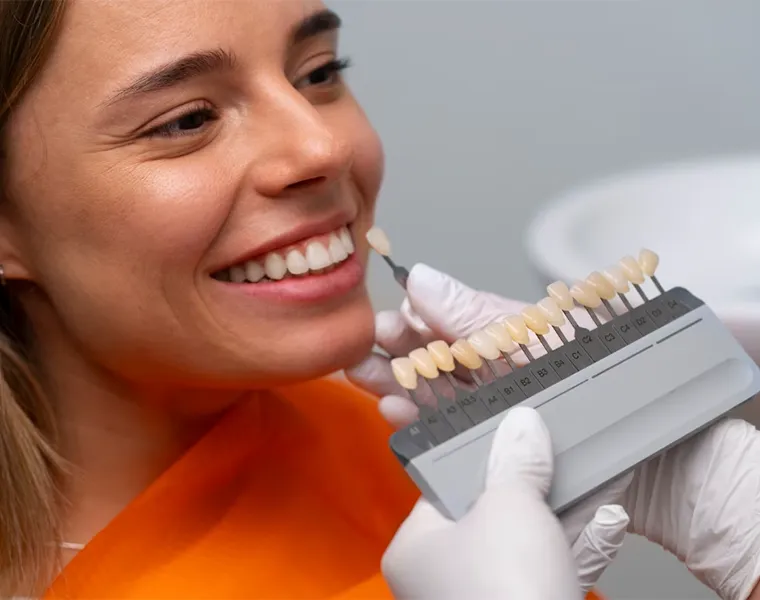What is prosthodontics? Prosthodontics is a branch of dentistry that aims to restore lost teeth functionally and aesthetically. This treatment method includes different applications such as prosthetic teeth, bridges, crowns and implants. By replacing missing teeth, chewing function and oral aesthetics are greatly improved. In addition, prosthodontic treatment contributes to maintaining oral health. This is because missing teeth can lead to the replacement of other teeth over time.
What is prosthodontics? This treatment is individualized according to the needs of the patient and the most suitable prosthesis or implant options are determined for the oral structure. Different types such as partial dentures, full dentures and fixed dentures are preferred according to the patient’s condition. The treatment process consists of taking mouth impressions, preparing the prosthesis and testing it in the mouth. Prosthodontic treatment is an ideal solution to restore the function of lost teeth. These treatment applications also positively affect facial aesthetics.
Who can receive prosthodontic treatment? This treatment is planned to be suitable for individuals of all age groups. Prosthodontics is used in the following cases.
- Individuals with tooth loss: Prosthetic applications are made to replace missing teeth to restore chewing function and improve aesthetic appearance.
- Those with disorders in the oral structure: Patients with deformation in the jaw structure due to tooth loss are supported with this treatment.
- Those with chronic dental problems: Bridge or crown applications are preferred for individuals who cannot fulfill the function of decayed or broken teeth.
- Those who need aesthetic dental treatment: Prosthetic teeth or implants are used in patients who want to improve their tooth structure and appearance.
What is Prosthodontic Treatment?
Prosthodontics is a branch of dentistry that aims to restore the function and appearance of lost/damaged teeth. This treatment method allows patients to regain their chewing function and eliminates aesthetic concerns. Prosthetic treatment plays an important role in preventing the negative effects of tooth loss on oral health.
There are two main types of prosthesis: fixed prosthesis and removable prosthesis.
Fixed prosthesis: This group includes bridges and crowns that are permanently attached to the teeth. They are known for optimizing chewing function.
Removable dentures: Includes dentures and partial dentures that can be easily removed from the mouth. It is suitable for individuals with partial or complete tooth loss.

Prosthetic treatment not only restores the functional capabilities of the teeth, but also contributes to the preservation of facial and jaw structure. In terms of aesthetics, aesthetic dental prostheses, which are specially prepared for patients with tooth loss, increase self-confidence in social life.
The treatment process begins with a comprehensive examination. The dentist creates the most appropriate treatment plan by examining the patient’s tooth structure and jaw condition. The treatment stages are usually as follows:
- Examination and planning: The patient’s needs are determined and a suitable prosthetic option is evaluated.
- Measurement: Mouth and jaw measurements are taken to prepare the prosthesis individually.
- Prosthesis application: The prepared dentures are tested in the mouth and final adjustments are made.
- Check-ups: The fit and functionality of the prosthesis are monitored with regular post-treatment check-ups.
Thanks to modern prosthodontic treatment methods, patients can achieve ideal results in terms of aesthetics and function. In addition to improving quality of life, this treatment also aims to protect oral health in the long term.

What is Prosthetic Dental Treatment, What Does It Do?
Prosthetic dental treatment, aimed at restoring the function and aesthetics of missing or damaged teeth, is a branch of dentistry. The practices in this field are carried out by prosthodontists who have received special training in dentistry and have specialized in the design and application of prostheses. This treatment is carried out with various types of prostheses, such as false teeth, bridges, etc.
Dental prostheses are artificial teeth designed to replace lost natural teeth. There are varieties such as sectional prostheses and removable prostheses. The number of missing teeth, age, and other factors of the patient determine the details of the application.
A false tooth is a type of prosthesis generally used in total tooth loss and is removable. These prostheses can be made of different materials, such as metal-supported, porcelain, or zirconium teeth. Porcelain dental coverings are mostly used to cover damaged teeth and restore their functions. These treatments provide an appearance and feel similar to natural teeth.
“Where to get an appointment for prosthetic dental treatment?”
Patients who want to make an appointment for prosthetic dental treatment can apply to state and university hospitals for these applications, as well as private dental clinics, which may provide shorter waiting times and more flexible appointment hours.
How prosthetic dental treatment is carried out varies depending on the type of prosthesis. The making of a prosthetic tooth involves stages such as taking measurements, designing the prosthesis, and applying it. Other details can be listed as follows:
Libredent performs many applications in this field. You can contact us for detailed information and appointments.











